Keeping Push Combinations Together
 Ropes made with Dyneema, ultra-high molecular weight polyethylene (UHMWPE), are proving a safe and secure alternative to steel wire rope for connecting barges and vessels in ‘push combinations’ working on inland waterways. Captain Grinwis and crew of the push combination Norma, with a lot of steel wire rope experience on other push combinations, are extremely satisfied with the new rope solution.
Ropes made with Dyneema, ultra-high molecular weight polyethylene (UHMWPE), are proving a safe and secure alternative to steel wire rope for connecting barges and vessels in ‘push combinations’ working on inland waterways. Captain Grinwis and crew of the push combination Norma, with a lot of steel wire rope experience on other push combinations, are extremely satisfied with the new rope solution.
In push combinations, the barge and the unpowered vessel in front of it have to be tightly lashed together to prevent any articulation. Traditional steel wire rope (SWR) is not only labour intensive, but can also be dangerous for the crew if individual strands snap, creating so-called fish hooks. The hard and heavy SWR can also damage decks, bollards and other equipment, leading to costly repairs and paint jobs.
Push Combination Norma
 The push combination ‘Norma’ has been operated by Captain Grinwis and his crew on the river Rhine between Basel and Rotterdam since July 2007. With a total length of 179m, a width of 11.5m and a capability of carrying loads of up to 336 TEU, it uses four Eurolest ropes made with Dyneema by Lankhorst Ropes in Sneek, the Netherlands. Captain Grinwis and his crew – all of whom have had a lot of previous experience with steel wire rope (SWR) on other push combinations – say they are extremely satisfied with the new solution offered by ropes.
The push combination ‘Norma’ has been operated by Captain Grinwis and his crew on the river Rhine between Basel and Rotterdam since July 2007. With a total length of 179m, a width of 11.5m and a capability of carrying loads of up to 336 TEU, it uses four Eurolest ropes made with Dyneema by Lankhorst Ropes in Sneek, the Netherlands. Captain Grinwis and his crew – all of whom have had a lot of previous experience with steel wire rope (SWR) on other push combinations – say they are extremely satisfied with the new solution offered by ropes.
Safe & Simple
The connecting ropes made with Dyneema are seven times lighter then SWR, yet offer greater strength at a comparable diameter, resulting in higher handling speeds and the involvement of fewer crew members. The ropes float on water and do not damage deck equipment, considerably reducing the need for repairs and paint jobs. “Handling the ropes with Dyneema is very simple”, says Captain Grinwis. “Connecting the barge can take just five minutes; in some cases disconnecting can take only two. Moreover, it requires just one crew member to do the job and there is no risk of fishhooks.”
The barge needs to be bound very tightly to the push vesseI in order to avoid unwanted swirling of the barge and to maintain sailing speed. Because of their very low elongation, the lines with Dyneema offer the advantage that once connected, tension within the ropes needs hardly any readjustment. “An occasional single click of the winch is often all that is required”, says Grinwis.
Marco Brinksma, account manager at Lankhorst Ropes adds: “Extensive tests during the start-up phase confirmed the outstanding performance of the ropes. Even under harsh conditions, i.e. high speed sailing combined with short and rapid turns of the push combination, independent movement of the container barge was kept to a minimum. The ropes did not slip and tension did not need to be readjusted.”
Reliable & Durable
The ropes were originally supplied with polyester jackets, but these proved susceptible to wear and tear around bollards. They have since been equipped with highly abrasion resistant covers made with Dyneema, which have proven much more reliable and durable.
After seven months in use, one of the ropes was subjected to test that showed its residual strength was only two percent lower than the original minimum break load (MBL). Taking into account that the rope broke in the test at its weakest point – the splice – this was an outstanding result. Another rope was tested after three years of continuous use. Despite the fact that the cover and core of the rope were damaged, a residual strength of approximately 70% of its original MBL was recorded – a similarly remarkable result. The other ropes are undamaged and are still in service.






